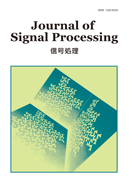Volume 25, Issue 6
Special Issue on Nonlinear Circuits, Communications and Signal Processing (Editor-in-Chief: Keikichi Hirose, Editor: Tetsuya Shimamura, Guest Editor: Yoko Uwate, Honorary Editor-in-Chief: Takashi Yahagi)
Displaying 1-10 of 10 articles from this issue
- |<
- <
- 1
- >
- >|
-
2021Volume 25Issue 6 Pages 203-212
Published: November 01, 2021
Released on J-STAGE: November 01, 2021
Download PDF (1138K) -
2021Volume 25Issue 6 Pages 213-220
Published: November 01, 2021
Released on J-STAGE: November 01, 2021
Download PDF (975K) -
2021Volume 25Issue 6 Pages 221-225
Published: November 01, 2021
Released on J-STAGE: November 01, 2021
Download PDF (970K) -
2021Volume 25Issue 6 Pages 227-231
Published: November 01, 2021
Released on J-STAGE: November 01, 2021
Download PDF (743K) -
2021Volume 25Issue 6 Pages 233-237
Published: November 01, 2021
Released on J-STAGE: November 01, 2021
Download PDF (636K) -
2021Volume 25Issue 6 Pages 239-243
Published: November 01, 2021
Released on J-STAGE: November 01, 2021
Download PDF (912K) -
2021Volume 25Issue 6 Pages 245-250
Published: November 01, 2021
Released on J-STAGE: November 01, 2021
Download PDF (761K) -
2021Volume 25Issue 6 Pages 251-255
Published: November 01, 2021
Released on J-STAGE: November 01, 2021
Download PDF (1283K) -
2021Volume 25Issue 6 Pages 257-261
Published: November 01, 2021
Released on J-STAGE: November 01, 2021
Download PDF (883K) -
2021Volume 25Issue 6 Pages 263-268
Published: November 01, 2021
Released on J-STAGE: November 01, 2021
Download PDF (1164K)
- |<
- <
- 1
- >
- >|
